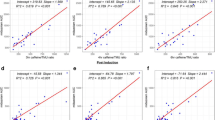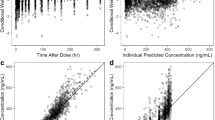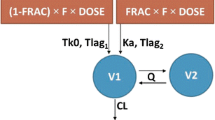Abstract
Objective: To explore the ability of the nonparametric expectation maximisation (NPEM) method of population pharmacokinetic modelling to deal with sparse data in estimating systemic caffeine clearance for monitoring and evaluation of cytochrome P450 (CYP) 1A2 activity.
Design and participants: Nonblind, single-dose clinical investigation in 34 non-related adult Bulgarian Caucasians (18 women and 16 men, aged between 18 and 62 years) with normal and reduced renal function.
Methods: Each participant received oral caffeine 3 mg/kg. Two blood samples per individual were taken according to the protocol for measuring caffeine plasma concentrations. A total of 67 measured concentrations were used to obtain NPEM estimates of caffeine clearance. Paraxanthine/caffeine plasma ratios were calculated and correlated with clearance estimates. Graphical methods and tests for normality were applied and parametric and nonparametric statistical tests were used for comparison.
Results: NPEM median estimates of caffeine absorption and elimination rate constants, ka = 4.54 h−1 and ke1 = 0.139 h−1, as well as of fractional volume of distribution and plasma clearance, VS1 = 0.58 L/kg and CLs1 = 0.057 L/h/kg, agreed well with reported values from more ‘data rich’ studies. Significant correlations were observed between paraxanthine/caffeine ratios at 3, 8 and 10 hours and clearance (Spearman rank correlation coefficients, rs, >0.74, p ≤ 0.04). Sex or renal function caused no significant differences in clearance. Heavy smokers and drinkers showed 2-fold higher CYP1A2 activity. Normality tests and graphical methods of analysing caffeine clearance supported a non-Gaussian and multicomponent distribution of CYP1A2 activity.
Conclusions: Collectively, the results show that the NPEM method is suitable and relevant for large-scale epidemiological studies of population phenotyping for cancer susceptibility and for abnormal liver function by monitoring CYP1A2 activity based on sparse caffeine data.







Similar content being viewed by others
References
Nebert DW, Nelson DR, Coon MJ, et al. The P450 superfamily: update on new sequences, gene mapping, and recommended nomenclature. DNA 1991; 10: 1–4
Ioannides C, Parke DV. The cytochrome P450 1 gene family of microsomal hemoproteins and their role in the metabolic activation of chemicals. Drug Metab Rev 1990; 22: 1–85
Shimada T, Iwasaki M, Martin MV, et al. Human liver microsomal cytochrome P-450 enzymes involved in the bioactivation of procarcinogens detected by umu gene response in Salmonella typhimurium TA 1535/pSK1002. Cancer Res 1989; 49: 3218–28
Eaton DL, Gallagher EP, Bammler TK, et al. Role of cytochrome P4501A2 in chemical carcinogenesis: implications for human variability in expression and enzyme activity. Pharmacogenetics 1995; 5: 259–74
Gonzalez FJ, Gelboin HV. Role of human cytochromes P450 in the metabolic activation of chemical carcinogens and toxins. Drug Metab Rev 1994; 26: 165–83
Carrillo JA, Benitez J. Clinically significant pharmacokinetic interactions between dietary caffeine and medications. Clin Pharmacokinet 2000; 39: 127–53
Schweikl H, Taylor JA, Kitareewan S, et al. Expression of CYP1A1 and CYP1A2 genes in human liver. Pharmacogenetics 1993; 3: 239–49
Shimada T, Yamazaki H, Mimura M, et al. Interindividual variations in human liver cytochrome P-450 enzymes involved in the oxidation of drugs, carcinogens and toxic chemicals: studies with liver microsomes of 30 Japanese and 30 Caucasians. J Pharmacol Exp Ther 1994; 270: 414–23
Denaro CP, Jacob III P, Benowitz NL. Evaluation of pharmacokinetic methods used to estimate caffeine clearance and comparison with a Bayesian forecasting method. Ther Drug Monit 1998; 20: 78–87
Bechtel YC, Haffen E, Lelouët H, et al. Relationship between the severity of alcoholic liver cirrhosis and the metabolism of caffeine in 226 patients. Int J Clin Pharmacol Ther 2000; 38: 467–75
Lelouët H, Bechtel YC, Paintaud G, et al. Caffeine metabolism in a group of 67 patients with primary biliary cirrhosis. Int J Clin Pharmacol Ther 2001; 39: 25–32
Bechtel YC, Lelouët H, Hrusovsky S, et al. Caffeine metabolism before and after liver transplantation. Int J Clin Pharmacol Ther 2001; 39: 53–60
Lelo A, Miners JO, Robson RA, et al. Quantitative assessment of caffeine partial clearances in man. Br J Clin Pharmacol 1986; 22: 183–6
Gu L, Gonzalez FJ, Kalow W, et al. Biotransformation of caffeine, paraxanthine, theobromine and theophylline by cDNA-expressed human CYP1A2 and CYP2E1. Pharmacogenetics 1992; 2: 73–7
Biomarkers Definitions Working Group. Biomarkers and surrogate endpoints: preferred definitions and conceptual framework. Clin Pharmacol Ther 2001; 69: 89–95
Jost G, Wahllander A, Von Mandach U, et al. Overnight salivary caffeine clearance: a liver function test suitable for routine use. Hepatology 1987; 7: 338–44
Nagel RA, Dirix LY, Hayllar KM, et al. Use of quantitative liver function tests: caffeine clearance and galactose elimination capacity: after orthotopic liver transplantation. J Hepatol 1990; 10: 149–57
Tanaka E, Ishikawa A, Yamamoto Y, et al. A simple useful method for the determination of hepatic function in patients with liver cirrhosis using caffeine and its three major dimethylmetabolites. Int J Clin Pharmacol Ther Toxicol 1992; 30: 336–41
Tang BK, Zhou Y, Kadar D, et al. Caffeine as a probe for CYP1A2 activity: potential influence of renal factors on urinary phenotypic trait measurements. Pharmacogenetics 1994; 4: 117–24
Denaro C, Brown CR, Wilson M, et al. Dose-dependency of caffeine metabolism with repeated dosing. Clin Pharmacol Ther 1990; 48: 277–85
Carrillo JA, Christensen M, Ramos SI, et al. Evaluation of caffeine as an in vivo probe for CYP1A2 using measurements in plasma, saliva, and urine. Ther Drug Monit 2000; 22: 409–17
Fuhr U, Rost KL. Simple and reliable CYP1A2 phenotyping by the paraxanthine/caffeine ratio in plasma and in saliva. Pharmacogenetics 1994; 4: 109–16
Butler MA, Lang NP, Young JF, et al. Determination of CYP1A2 and NAT2 phenotypes in human populations by analysis of caffeine urinary metabolites. Pharmacogenetics 1992; 2: 116–27
Lang NP, Butler MA, Massengill J, et al. Rapid metabolic phenotypes for acetyltransferase and cytochrome P4501A2 and putative exposure to food-borne heterocyclic amines increase risk for colorectal cancer or polyps. Cancer Epidemiol Biomark Prevent 1994; 3: 675–82
Nakajima M, Yokoi T, Mizutani M, et al. Phenotyping of CYP1A2 in Japanese population by analysis of caffeine urinary metabolites: absence of mutation prescribing the phenotype in the CYP1A2 gene. Cancer Epidemiol Biomarkers Prev 1994; 3: 415–21
Rostami-Hodjegam A, Nurminen S, Jackson PR, et al. Caffeine urinary metabolite ratios as markers of enzyme activity: a theoretical assessment. Pharmacogenetics 1996; 6: 121–49
Schrenk D, Brockmeier D, Mörike K, et al. A distribution study of CYP1A2 phenotypes among smokers and non-smokers in a cohort of healthy Caucasian volunteers. Eur J Clin Pharmacol 1998; 53: 361–7
Jelliffe RW, Schumitzky A, Bayard D, et al. Model-based, goal-oriented, individualised drug therapy. Clin Pharmacokinet 1998; 34: 57–77
Mallet A. A maximum likelihood estimation method for random coefficient regression models. Biometrika 1986; 73: 645–56
Schumitzky A. Nonparametric EM algorithms for estimating prior distributions. Appl Math Comput 1991; 45: 143–57
Jerling M, Merlé Y, Mentré F, et al. Population pharmacokinetics of nortriptyline during monotherapy and during concomitant treatment with drugs that inhibit CYP2D6: an evaluation with the nonparametric maximum likelihood method. Br J Clin Pharmacol 1994; 38: 453–62
Preston SL, Drusano GL. Nonparametric expectation maximization population modeling of ganciclovir. J Clin Pharmacol 1996; 36: 301–10
Terziivanov D, Atanasova I, Dimitrova V. Population pharmacokinetics of ciprofloxacin in patients with liver impairments analyzed by NPEM2 algorithm: a retrospective study. Int J Clin Pharmacol Ther 1998; 36: 376–82
Terziivanov D, Atanasova I, Dimitrova V, et al. Pharmacokinetic variability of nimodipine disposition after single and multiple oral dosing to hypertensive renal failure patients: parametric and nonparametric population analysis. Int J Clin Pharmacol Ther 1999; 37: 404–12
Jelliffe RW, Schumitzky A, Van Guilder M. User manual for version 10.6 of the USC*PACK collection of PC programs. Los Angeles (CA): Laboratory of Applied Pharmacokinetics, University of Southern California. School of Medicine, 1995
Jeliffe RW, Jeliffe SM. A computer program for estimation of creatinine clearance from unstable serum creatinine levels, age, sex and weight. Math Biosci 1972; 14: 17–24
Bonati M, Latini R, Galetti F, et al. Caffeine disposition after oral doses. Clin Pharmacol Ther 1982; 32: 98–106
Blanchard J, Sawers SJA. The absolute bioavailability of caffeine in man. Eur J Clin Pharmacol 1983; 24: 93–7
Grant DM, Tang BK, Kalow W. Variability in caffeine metabolism. Clin Pharmacol Ther 1983; 33: 591–602
Bojinova C, Terziivanov D. Measurement of drug concentrations in biological fluids for the purposes of population pharmacokinetic analysis: I. validation of HPLC assay for simultaneous determination of caffeine and its primary metabolites in blood and urine [in Bulgarian]. Anal Lab 1997; 6: 142–8
Ette EI. Stability and performance of a population pharmacokinetic model. J Clin Pharmacol 1997; 37: 486–95
Sheiner LB, Beal SL. Some suggestions for measuring predictive performance. J Pharmacokinet Biopharm 1981; 9: 503–12
Afifi AA, Azen SP. Statistical analysis: a computer oriented approach [in Russian]. Moscow: Mir, 1982
Tantcheva-Poór I, Zaigler M, Rietbrock S, et al. Estimation of cytochrome P-450 CYP1A2 activity in 863 healthy Caucasians using a saliva-based caffeine test. Pharmacogenetics 1999; 9: 131–44
Shapiro SS, Wilk MB. An analysis of variance test for normality (complete samples). Biometrika 1965; 52: 591–611
Butler MA, Iwasaki M, Guengerich FP, et al. Human cytochrome P450PA (P450IA2), the phenacetin O-deethylase, is primarily responsible for the hepatic 3-demethylation of caffeine and N-oxidation of carcinogenic arylamines. Proc Natl Acad Sci U S A 1989; 86: 7696–700
Kalow W, Tang BK. The use of caffeine for enzyme assays: a critical appraisal. Clin Pharmacol Ther 1993; 53: 503–14
Guengerich FP. Human cytochrome P450 enzymes. In: Ortiz de Montellano PR, editor. Cytochrome P450. 2nd ed. New York: Plenum, 1995: 473–535
Kadlubar FF. Biochemical individuality and its implications for drug and carcinogen metabolism. Recent insights from acetyl-transferase and cytochrome P4501A2 phenotyping and genotyping in humans. Drug Metab Dispos 1994; 26: 37–46
Guengerich FP, Parikh A, Turesky RJ, et al. Inter-individual differences in the metabolism of environmental toxicants: cytochrome P450 1A2 as a prototype. Mutat Res 1999; 428: 115–24
Campbell ME, Spielberg SP, Kalow W. A urinary metabolite ratio that reflects systemic caffeine clearance. Clin Pharmacol Ther 1987; 42: 157–65
Ullrich D, Compagnone D, Münch B, et al. Urinary caffeine metabolites in man: age-dependent changes and pattern in various clinical situations. Eur J Clin Pharmacol 1992; 43: 167–72
Relling MV, Lin J-S, Ayers G, et al. Racial and gender differences in N-acetyltransferase, xanthine oxidase, and CYP1A2* activities. Clin Pharmacol Ther 1992; 52: 643–58
Kalow W, Tang BK. Use of caffeine metabolite ratios to explore CYP1A2 and xanthine oxidase activities. Clin Pharmacol Ther 1991; 50: 508–19
Kashuba ADM, Bertino JS, Kearns GL, et al. Quantitation of three-month intraindividual variability and influence of sex and menstrual cycle phase on CYP1A2, N-acetyltransferase-2, and xanthine oxidase activity determined with caffeine phenotyping. Clin Pharmacol Ther 1998; 63: 540–51
Zaigler M, Rietbrock S, Szymanski J, et al. Variation of CYP1A2-dependent caffeine metabolism during menstrual cycle in healthy women. Int J Clin Pharmacol Ther 2000; 38: 235–44
Kalow W, Tang BK. Caffeine as a metabolic probe: exploration of the enzyme-inducing effect of cigarette smoking. Clin Pharmacol Ther 1991; 49: 44–8
Harder S, Staib AH, Beer C, et al. 4-Quinolones inhibit biotransformation of caffeine. Eur J Clin Pharmacol 1988; 35: 651–6
Healy PD, Polk RE, Kanawati L, et al. Interaction between oral ciprofloxacin and caffeine in normal volunteers. Antimicrob Agents Chemother 1989; 33: 474–8
Kadlubar FF, Talaska G, Butler MA, et al. Determination of carcinogenic arylamine N-oxidation phenotype in humans by analysis of caffeine urinary metabolites. In: Mendelsohn ML, Albertini RJ, editors. Mutation and the environment. Part B: metabolism, testing methods, and chromosomes. New York: Wily-Liss, 1990: 107–14
Vesell ES, Gaylor DW. Limitations of probit plots in pharmacogenetics: requirement of genetic analyses to test hypotheses based on graphical methods. Pharmacogenetics 1995; 5: 18–23
Jackson PR, Tucker GT, Woods HF. Testing for bimodality in frequency distributions of data suggesting polymorphisms of drug metabolism: histograms and probit plots. Br J Clin Pharmacol 1989; 28: 647–53
Jackson PR, Tucker GT, Woods HF. Testing for bimodality in frequency distributions of data suggesting polymorphisms of drug metabolism: hypothesis testing. Br J Clin Pharmacol 1989; 28: 655–62
Endrenyi L, Patel M. A new, sensitive graphical method for detecting deviations from the normal distribution of drug response: the NTV plot. Br J Clin Pharmacol 1991; 32: 159–66
Karlsson MO, Sheiner LB. The importance of modeling interoccasion variability in population pharmacokinetic analyses. J Pharmacokinet Biopharm 1993; 21: 735–50
Schmider J, Brockmöller J, Arold G, et al. Simultaneous assessment of CYP3A4 and CYP1A2 activity in vivo with alprazolam and caffeine. Pharmacogenetics 1999; 9: 725–34
Spigset O, Hägg S, Söderström E, et al. The paraxanthine:caffeine ratio in serum or in saliva as a measure of CYP1A2 activity: when should the sample be obtained? Pharmacogenetics 1999; 9: 409–12
Acknowledgements
The authors are deeply indebted to Roger W. Jelliffe, MD, for generously making available to them the USC*PACK collection of PC programs, v.10.6. They also wish to express their sincere gratitude to him for working with them on the revised version of the manuscript. The authors have provided no information on sources of funding or on conflicts of interest directly relevant to the content of this study.
Author information
Authors and Affiliations
Corresponding author
Rights and permissions
About this article
Cite this article
Terziivanov, D., Bozhinova, K., Dimitrova, V. et al. Nonparametric Expectation Maximisation (NPEM) Population Pharmacokinetic Analysis of Caffeine Disposition from Sparse Data in Adult Caucasians. Clin Pharmacokinet 42, 1393–1409 (2003). https://doi.org/10.2165/00003088-200342150-00006
Published:
Issue Date:
DOI: https://doi.org/10.2165/00003088-200342150-00006




